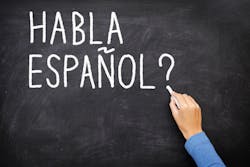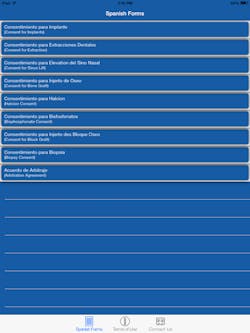No need for a translator: Spanish consent and instructional apps for orthodontic and implant dentistry
If you answered "a," "b," or "c," this is for you.
At present, at least 10% of dental patients in the United States are Spanish-speaking. Demographic trends show that this number will continue to grow in the future. While providers of general dentistry have made strides in developing Spanish consent and procedural information forms, orthodontic and implant providers still tend to use English forms. These forms are often translated to Spanish-speaking patients by staff members — or worse — by children or other family members who have little knowledge of orthodontic or implant dentistry.
Although some offices will document the name of the person translating the forms in the patient’s chart, an attorney or risk management company will tell you that these forms aren’t worth the paper on which they’re written. Legally acceptable consent requires a “meeting of the minds.” In other words, the patient receiving the treatment must fully understand the treatment in order to give consent that will stand up legally. If a primarily Spanish-speaking parent of an orthodontic patient or a primarily Spanish-speaking implant patient signs a form that is written in English, their consent is easily disputable.
Protect yourself! Spanish Ortho Expert and Spanish Implant Expert are two new apps that can be used with Spanish-speaking patients (or parents of patients) of orthodontic and implant dentistry. The apps contain a variety of documents used in orthodontic and implant dentistry, translated into Spanish.
Spanish Ortho Expert contains the following types of documents:
- A consent form for orthodontic treatment;
- A financial contract for orthodontic treatment;
- A list of American Dental Association procedure codes with a description of each code;
- A list of foods to avoid or reduce consumption of during orthodontic treatment;
- Oral hygiene instructions;
- Rapid palatal expander information and instructions;
- A deband consent form and instructions;
- Tru-Tain information and instructions;
- Schwarz information and instructions;
- Lower lingual fixed arch instructions and information; and
- Retainer instructions.
Spanish Implant Expert contains the following types of documents:
- An implant placement consent form with a description of alternatives to implant treatment;
- A lateral window sinus lift consent form;
- A biopsy consent form;
- A bone graft (socket graft) consent form;
- A tooth extraction consent form;
- A Halcion sedation consent form;
- An implant surgery consent form for patients who have taken bisphosphonates;
- A block graft consent form;
- Post-operative instructions; and
- An arbitration agreement.
The documents are customizable and include blank areas for writing in additional instructions, as well as options that can be circled to customize instructions for individual patients. All of the documents were professionally translated and reviewed by a lawyer prior to being added to the app. Each document can be viewed, downloaded, or saved as a PDF. The documents can also be opened in Apple iBooks, shared via email, or sent to a wireless printer. Soon, they will be available through Google, as well. For a preview, visit spanishdentalforms.com. The apps are available through iTunes and Google and will soon be available in the Android Play Store, as well.
Screenshots from Spanish Ortho Expert (left) and Spanish Implant Expert(right)
(click to enlarge)
As a practicing dentist in Southern California, I recognized the need for these apps about a year ago when I saw a huge influx of Spanish-speaking patients in my practice, which provides both orthodontic and implant treatment. We started looking for consent forms in Spanish but could not find a comprehensive set of documents for common procedures in orthodontic or implant dentistry.
Since most orthodontic patients are children or adolescents with parents who sign their consent forms, I wanted the parents of orthodontic patients to understand the procedures to which they were consenting for their children. I also wanted my Spanish-speaking implant patients to have the means to understand implant dentistry. So, we wrote English documents and translated them into Spanish. Then, we created mobile apps to share these documents with fellow dentists. My Spanish-speaking patient population has doubled, and I expect that this number will continue to increase.
Having Spanish documents on hand can facilitate clearer communication with Spanish-speaking patients. Your patients will feel more comfortable with agreeing to necessary treatment, and you will feel that you and your patient are on the same page.
Editor's Note: Dr. Jain will be available to discuss the apps at the 2014 American Dental Association Annual Session, the 2014 American Academy of Implant Dentistry Annual Educational Conference, and the 2015 American Association of Orthodontists Annual Session.


